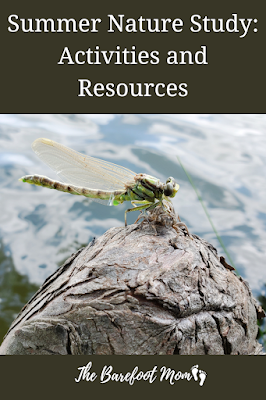Summer is such a great time of year for exploring the natural world! There are lots of insects out and about to observe, plants and gardens to watch grow, and warm evenings that are perfect for stargazing!
Below I share some of my favorite summer nature study activities and lots of nature study resources to check out.
Summer Nature Study Activities
Watch Fireflies
Fireflies are one of my favorite things about summer. Get outside in the evening and enjoy them!
Here are a few resources for learning about fireflies:
-National Geographic: Watch Fireflies Glowing in Sync to Attract Mates (video)
-SciShow Kids: Fireflies- Nature's Baffling Blinkers (video)
-Kristin Moon Science: Fascinating Fireflies- The Science Behind the Glow
Learn About Cicadas
Cicadas buzzing in the trees is a sure sign that summer is here. Look around your yard and see if you can find any to observe. If you get lucky you might find one in the process of molting.
Here are a few resources for learning about cicadas:
-BBC Earth: Periodical Cicads Overrun the Forest (video)
-SciShow Kids: Cicadas- The Loudest Bug in the World! (video)
Study Pond Life
Find a local pond to poke around and look for wildlife to study. Some animals you might come across include tadpoles and frogs, dragonflies, wading birds, fish, and butterflies. Bring sketchbooks or a camera to record what you see.
If you have a microscope, you can collect some pond water samples to look at up close under the microscope. Ponds are full of microscope life!
Learn About Plant Anatomy and Reproduction
Summer is the perfect time for learning about plant anatomy and plant lifecycles, especially if you're growing a backyard garden. Here are a few resources to check out:
-Homeschool Pop: Plant Parts and Functions (video)
-SciShow Kids: Look Inside a Flower (video)
Go on a Mini Beast Hunt
Grab an insect guide and hunt around your yard or neighborhood for insects and other creepy crawlies to check out and try to ID. Encourage your kids to sketch or photograph some of their favorites.
Learn About the Dragonfly Lifecycle
Did you know that dragonflies spend the majority of their lives (up to several years) as aquatic nymphs? Dragonflies only emerge from the water just before their final molt. They spend just a few weeks in the adult phase of their lifecycle, just enough time to reproduce.
To learn more about these fascinating insects, check out these resources:
-National Geographic: From Nymph to Wings, the Dragonfly Lifecycle (video)
-Insect Identification: Dragonflies and Damselflies
Go Star Gazing
Take advantage of these warm summer nights and get outside after dark for some night sky gazing. The SkyView app is really helpful for locating planets, constellations, and other celestial objects. The lite version is available for free in both the Google Play Store and the Apple App Store.
Watch the Perseid Meteor Shower
The Perseids are usually one of the best meteor showers of the year. The Perseids will be visible from around July 17th through August 24th, peaking around August 13th.
Beach Study
If you live near the beach or plan on visiting one this summer, take time to observe the wildlife on the beach and in the tide pools. If your kids like to draw or take pictures, encourage them to sketch or photograph what they see.
Go Foraging for Summer Edibles
Go foraging for summer edibles. Some common ones in the US include blackberries, dandelions, plantain, lemon balm, wild strawberries, wild grapes, and purslane.
When it comes to foraging, don't eat it unless you are 100% sure about the ID. If you are newer to foraging, look around your area for a foraging class.
Summer Nature Study Resources
Apps
-iNaturalist (wildlife identification app)
-SkyView (night sky app)
-Pictute Insect (insect identification app)
Books
-Golden Field Guide: Reptiles and Amphibians
-The Secret Lives of Backyard Bugs
-Practical Naturalist: Field Guide: an illustrated guide to the natural world
Websites
If you enjoyed this post, check out:
Learning in the Garden Printable Unit Study
All About Insects Printable Learning Pack
Follow me on





Comments
Post a Comment